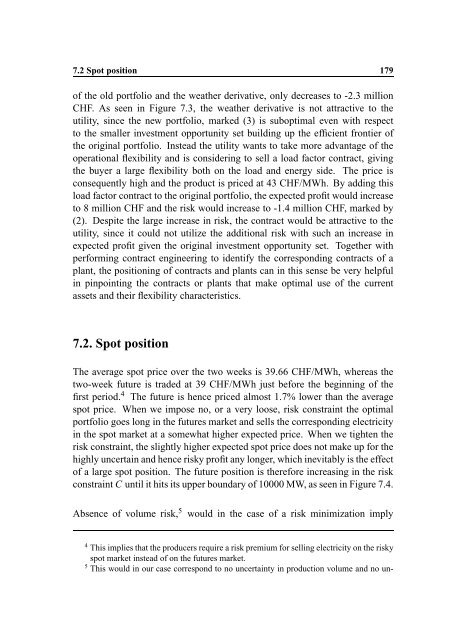Hedging Strategy and Electricity Contract Engineering - IFOR
Hedging Strategy and Electricity Contract Engineering - IFOR
Hedging Strategy and Electricity Contract Engineering - IFOR
You also want an ePaper? Increase the reach of your titles
YUMPU automatically turns print PDFs into web optimized ePapers that Google loves.
7.2 Spot position 179<br />
of the old portfolio <strong>and</strong> the weather derivative, only decreases to -2.3 million<br />
CHF. As seen in Figure 7.3, the weather derivative is not attractive to the<br />
utility, since the new portfolio, marked (3) is suboptimal even with respect<br />
to the smaller investment opportunity set building up the efficient frontier of<br />
the original portfolio. Instead the utility wants to take more advantage of the<br />
operational flexibility <strong>and</strong> is considering to sell a load factor contract, giving<br />
the buyer a large flexibility both on the load <strong>and</strong> energy side. The price is<br />
consequently high <strong>and</strong> the product is priced at 43 CHF/MWh. By adding this<br />
load factor contract to the original portfolio, the expected profit would increase<br />
to 8 million CHF <strong>and</strong> the risk would increase to -1.4 million CHF, marked by<br />
(2). Despite the large increase in risk, the contract would be attractive to the<br />
utility, since it could not utilize the additional risk with such an increase in<br />
expected profit given the original investment opportunity set. Together with<br />
performing contract engineering to identify the corresponding contracts of a<br />
plant, the positioning of contracts <strong>and</strong> plants can in this sense be very helpful<br />
in pinpointing the contracts or plants that make optimal use of the current<br />
assets <strong>and</strong> their flexibility characteristics.<br />
7.2. Spot position<br />
The average spot price over the two weeks is 39.66 CHF/MWh, whereas the<br />
two-week future is traded at 39 CHF/MWh just before the beginning of the<br />
first period. 4 The future is hence priced almost 1.7% lower than the average<br />
spot price. When we impose no, or a very loose, risk constraint the optimal<br />
portfolio goes long in the futures market <strong>and</strong> sells the corresponding electricity<br />
in the spot market at a somewhat higher expected price. When we tighten the<br />
risk constraint, the slightly higher expected spot price does not make up for the<br />
highly uncertain <strong>and</strong> hence risky profit any longer, which inevitably is the effect<br />
of a large spot position. The future position is therefore increasing in the risk<br />
constraint C until it hits its upper boundary of 10000 MW, as seen in Figure 7.4.<br />
Absence of volume risk, 5 would in the case of a risk minimization imply<br />
4 This implies that the producers require a risk premium for selling electricity on the risky<br />
spot market instead of on the futures market.<br />
5 This would in our case correspond to no uncertainty in production volume <strong>and</strong> no un-
















